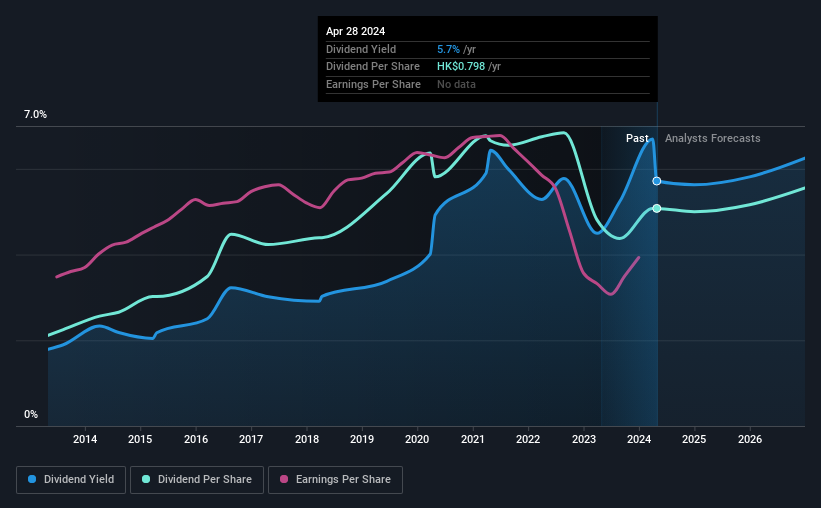- Hong Kong
- /
- Real Estate
- /
- SEHK:688
China Overseas Land & Investment (HKG:688) Is Increasing Its Dividend To CN¥0.45

China Overseas Land & Investment Limited (HKG:688) has announced that it will be increasing its dividend from last year's comparable payment on the 12th of July to CN¥0.45. This takes the annual payment to 5.7% of the current stock price, which is about average for the industry.
View our latest analysis for China Overseas Land & Investment
China Overseas Land & Investment's Earnings Easily Cover The Distributions
We like a dividend to be consistent over the long term, so checking whether it is sustainable is important. Before making this announcement, China Overseas Land & Investment was easily earning enough to cover the dividend. As a result, a large proportion of what it earned was being reinvested back into the business.
Looking forward, earnings per share is forecast to rise by 10.2% over the next year. If the dividend continues along recent trends, we estimate the payout ratio will be 33%, which is in the range that makes us comfortable with the sustainability of the dividend.

Dividend Volatility
While the company has been paying a dividend for a long time, it has cut the dividend at least once in the last 10 years. The dividend has gone from an annual total of CN¥0.307 in 2014 to the most recent total annual payment of CN¥0.739. This works out to be a compound annual growth rate (CAGR) of approximately 9.2% a year over that time. It's good to see the dividend growing at a decent rate, but the dividend has been cut at least once in the past. China Overseas Land & Investment might have put its house in order since then, but we remain cautious.
Dividend Growth Is Doubtful
With a relatively unstable dividend, it's even more important to evaluate if earnings per share is growing, which could point to a growing dividend in the future. It's not great to see that China Overseas Land & Investment's earnings per share has fallen at approximately 7.4% per year over the past five years. If the company is making less over time, it naturally follows that it will also have to pay out less in dividends. Earnings are predicted to grow over the next year, but we would remain cautious until a track record of earnings growth is established.
In Summary
In summary, while it's always good to see the dividend being raised, we don't think China Overseas Land & Investment's payments are rock solid. In the past, the payments have been unstable, but over the short term the dividend could be reliable, with the company generating enough cash to cover it. This company is not in the top tier of income providing stocks.
Companies possessing a stable dividend policy will likely enjoy greater investor interest than those suffering from a more inconsistent approach. However, there are other things to consider for investors when analysing stock performance. For instance, we've picked out 1 warning sign for China Overseas Land & Investment that investors should take into consideration. Is China Overseas Land & Investment not quite the opportunity you were looking for? Why not check out our selection of top dividend stocks.
New: AI Stock Screener & Alerts
Our new AI Stock Screener scans the market every day to uncover opportunities.
• Dividend Powerhouses (3%+ Yield)
• Undervalued Small Caps with Insider Buying
• High growth Tech and AI Companies
Or build your own from over 50 metrics.
Have feedback on this article? Concerned about the content? Get in touch with us directly. Alternatively, email editorial-team (at) simplywallst.com.
This article by Simply Wall St is general in nature. We provide commentary based on historical data and analyst forecasts only using an unbiased methodology and our articles are not intended to be financial advice. It does not constitute a recommendation to buy or sell any stock, and does not take account of your objectives, or your financial situation. We aim to bring you long-term focused analysis driven by fundamental data. Note that our analysis may not factor in the latest price-sensitive company announcements or qualitative material. Simply Wall St has no position in any stocks mentioned.
About SEHK:688
China Overseas Land & Investment
An investment holding company, engages in the property development and investment, and other operations in the People’s Republic of China and the United Kingdom.
Excellent balance sheet and fair value.
Similar Companies
Market Insights
Community Narratives



